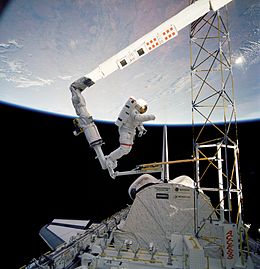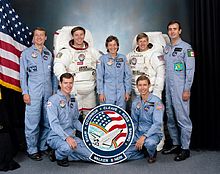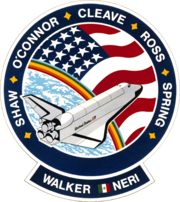STS-61-B

Construction of the ACCESS structure.
|
|
| Mission type | Satellite deployment Technology |
|---|---|
| Operator | NASA |
| COSPAR ID | 1985-109A |
| SATCAT no. | 16273 |
| Mission duration | 6 days, 21 hours, 4 minutes, 49 seconds |
| Distance travelled | 3,970,181 kilometres (2,466,956 mi) |
| Orbits completed | 109 |
| Spacecraft properties | |
| Spacecraft | Space Shuttle Atlantis |
| Launch mass | 118,664 kilograms (261,609 lb) |
| Landing mass | 93,316 kilograms (205,727 lb) |
| Payload mass | 21,791 kilograms (48,041 lb) |
| Crew | |
| Crew size | 7 |
| Members |
Brewster H. Shaw, Jr. Bryan D. O'Connor Jerry L. Ross Mary L. Cleave Sherwood C. Spring Charles D. Walker Rodolfo Neri Vela |
| Start of mission | |
| Launch date | 27 November 1985, 00:29:00 UTC |
| Launch site | Kennedy LC-39A |
| End of mission | |
| Landing date | 3 December 1985, 21:33:49 UTC |
| Landing site | Edwards Runway 22 |
| Orbital parameters | |
| Reference system | Geocentric |
| Regime | Low Earth |
| Perigee | 361 kilometres (224 mi) |
| Apogee | 370 kilometres (230 mi) |
| Inclination | 28.5 degrees |
| Period | 91.9 min |
 Back row L-R: Walker, Ross, Cleave, Spring, Neri Vela Front row L-R: O'Conner, Shaw |
|
STS-61-B was NASA's 23rd Space Shuttle mission, and its second using Space Shuttle Atlantis. The shuttle was launched from Kennedy Space Center, Florida, on 26 November 1985. During STS-61-B, the shuttle crew deployed three communications satellites, and tested techniques of constructing structures in orbit. Atlantis landed at Edwards Air Force Base, California, at 16:33 EST on 3 December 1985, after 6 days and 21 hours in orbit.
STS-61-B marked the quickest turnaround of a Shuttle orbiter from launch to launch in history – just 54 days elapsed between Atlantis' launch on STS-51-J and launch on STS-61-B. The mission was also notable for carrying the first and until today only Mexican astronaut, Rodolfo Neri Vela.
After landing at the Edwards Air Force Base at the end of STS-51-J on 7 October 1985, Atlantis returned to the Kennedy Space Center on 12 October. The shuttle was moved directly into an Orbiter Processing Facility (OPF), where post-flight de-servicing and pre-flight processing took place simultaneously.
After only 26 days in the OPF, a record fast processing in the history of the Space Shuttle program, the shuttle was rolled to the Vehicle Assembly Building on 7 November.Atlantis was mated with the External Tank and Solid Rocket Booster stack and was rolled out to launch pad 39A on 12 November 1985.
Three satellites were deployed during the mission: Aussat 2, Morelos II, and Satcom K2. The first two were the second in their series, the first examples having been deployed during STS-51-I and STS-51-G. Both were Hughes HS-376 satellites equipped with a PAM-D booster to reach geosynchronous transfer orbit. Satcom K2, meanwhile, was a version of the RCA 4000 series. RCA American Communications owned and operated the satellite system of which Satcom K2 was a part. The satellite was deployed using a PAM-D2 booster, a larger version of the PAM-D. This was the first flight of this booster stage on a Space Shuttle.
...
Wikipedia

